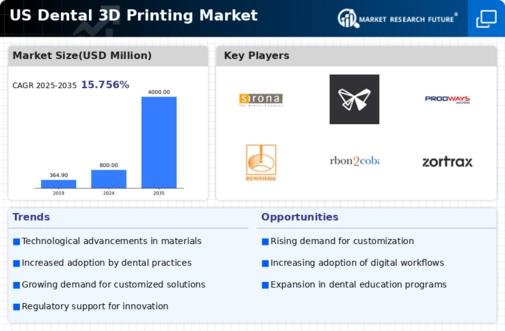The US Dental 3D Printing Market has seen significant growth in recent years, driven by technological advancements and an increasing demand for cost-effective and efficient dental solutions. As the adoption of 3D printing technologies continues to rise, dental professionals and laboratories are seeking innovative ways to improve patient outcomes and streamline production processes. Various players in the market are striving to differentiate themselves through the development of new materials and specialized equipment that cater specifically to denta applications.
The competitive landscape is characterized by a blend of established firms and emerging startups, all competing to capture a share of this lucrative market. This competitive environment not only fosters innovation but also enhances the overall quality of services available to dental practitioners, making 3D printing a vital component of modern dentistry in the United States.
Sirona Dental Systems stands out in the US Dental 3D Printing Market as a leader known for its commitment to integrating digital technologies into dental practices. The company has built a strong reputation based on its advanced software systems and state-of-the-art 3D printers that facilitate the creation of dental devices such as crowns, bridges, and dentures with unparalleled precision. Their significant market presence is bolstered by a range of products designed to enhance workflow efficiency, helping dental professionals achieve better patient outcomes.
Sirona Dental Systems has a robust network of partnerships with dental professionals and service providers, further ensuring its position as a trusted name in the industry. Its strengths lie in its comprehensive product offerings that cater to the complexities of dental procedures and its strong focus on research and development to maintain technological leadership within the US market.
Formlabs is another prominent player in the US Dental 3D Printing Market, recognized for its innovative solutions tailored to dental applications. The company offers a diverse portfolio of 3D printing systems, resins, and software that can produce highly detailed dental models and prototypes, directly meeting the needs of dental labs and practitioners. Formlabs has a strong market presence, built on user-friendly products that emphasize accessibility and affordability without compromising quality. Its key products include dental-specific resins and printing systems that enable fast prototyping and production of dental appliances.
Additionally, Formlabs has been proactive in strategic alliances and collaborations to expand their reach within the US dental community. Their strengths are reflected in their ability to rapidly iterate and improve their product line based on user feedback, which helps maintain a competitive edge in a dynamic market. The combination of innovative technology and a focus on customer needs positions Formlabs favorably in the evolving landscape of dental 3D printing in the United States.
























Leave a Comment